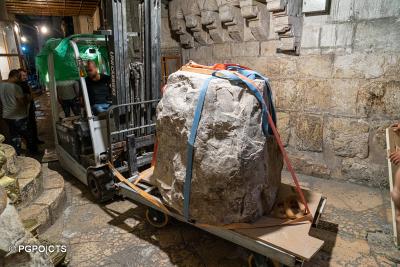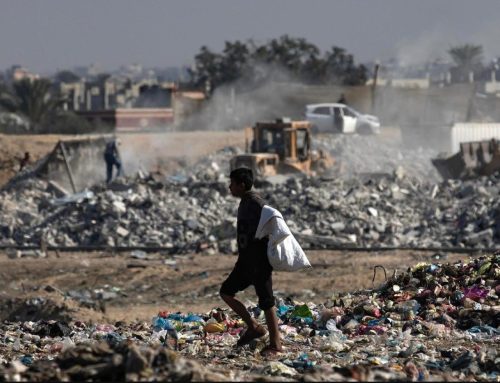The transfer of the base of the column from the Basilica of the Holy Sepulchre to the archaeological museum
Following in the centuries-old tradition of working on recovering and restoring the Christian artistic heritage in the Holy Land, the Custody continues to protect its artistic treasures through actions of relocating and enhancing archaeological finds of considerable interest to reconstruct and protect the history of these Holy Places.
On Wednesday 19th October, at the first light of dawn, the very delicate transfer of a base of a column from the Basilica of the Holy Sepulchre to the archaeological museum at the Studium Biblicum Franciscanum was concluded. There, it will be displayed to the public together with the rich archaeological collection of the future “Holy Sepulchre” room of the Terra Sancta Museum, designed by Giovanni Tortelli (architect of the archaeological section) to bring together in a single location the finds linked to the history of one of the most precious places for Christians.
The operation took place before the curious eyes of pilgrims and passers-by, considering that the exceptional transport (which was carried out in several phases, as the base is fractured in three pieces, for a total weight of about 7 tons) went through the Old City along the main thoroughfare: the delicate feat required the close collaboration of technicians (the architects Vincenzo Zuppardo and Leonardo Di Marco), archaeologists (fr. Amedeo Ricco archaeologist of the Studium Biblicum Franciscanum) and a local labour force (the team managed by Youssef Musallam), who dealt with the material transport.
The plinth from the age of Hadrian
The architectonic element in question is of particular historical and artistic interest as it is a base plinth (the element that supports the column), attributed to the first decades of the 2nd century (specifically to the reign of Hadrian 117-138). The most accredited hypothesis is that it belongs to the group of columns of the pagan temple built by the emperor on the place of Christ’s tomb, in the area of Golgotha. Later, when the Basilica of the Holy Sepulchre was built by Constantine in 325, these elements were used again several times over the centuries; then, because of a devastating fire, from 1809, what remained of the columns – now reduced to fragments – was hidden from view, because it was part of the walls built to repair the damage that had occurred.
“During the phase of restoration and excavations of the basilica from 1960 onwards, explains the archaeologist Fr. Amedeo Ricco, who carefully followed all the phases of the transport, “surviving columns and capitals from the Franciscan part of the basilica and therefore belonging to the Latins, were rediscovered and transported by the Franciscans to Gethsemane around 1975 and have recently been placed in the museum of the Studium Biblicum Franciscanum. The only piece that was missing was precisely this one, the base plinth of the column, which had remained for over 50 years in the basilica, probably due to the extreme difficulty of transporting it, but also because of the sudden death of the Dominican Father Charles Coüasnon, the architect who directed the restoration. Thanks to our research in the archives of recent years, we have been able to reconstruct its origin: from the colonnade owned by the Latins, exactly like all the other pieces already transported to the museum. This way, in joint agreement with the other communities present in the basilica, today we have at last reunited the plinth with the other architectonic elements that made up the colonnade of the Constantine Rotonda.”
When the transport of the plinth was over, the technicians and workmen who conducted and supervised the move, looked relieved and satisfied, as the movement required considerably complex and articulated passages, especially in some points of the Old City. Fr. Eugenio Alliata, archaeologist and director of the archaeological section of the Terra Sancta Museum, also took part in the successful conclusion of transferring the base of the column: “It was the great Father Virgilio Corbo who, for the Franciscans, did the first archaeological analyses on these finds of the basilica,” Fr. Alliata recalls. Toady, after so many years, the favourable circumstances have been created to resume this work, which will lead to increasingly greater knowledge about the basilica and its history.”
Silvia Giuliano | custodia.org






